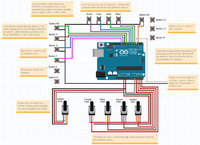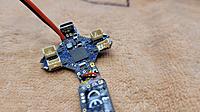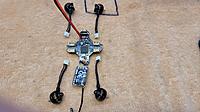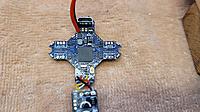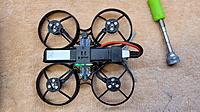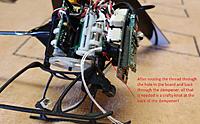Comments (0)
Add Comment
-
 Views: 144
Views: 144
Figure 1: A perfect travel package! -
 Views: 133
Views: 133
Figure 2: TBS Tango 2 Pro with a Multi-Protocol-Module. -
 Views: 147
Views: 147
Figure 3: Multi-Protocol-Module attached to back of TBS Tango 2. -
 Views: 126
Views: 126
Figure 4: Multi-Protocol-Module removed from adapter bay. -
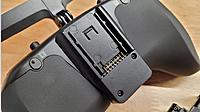 Views: 127
Views: 127
Figure 5: Adapter bay is a separate item that may be installed onto the back of the Tango 2. -
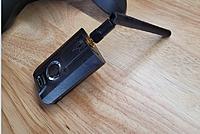 Views: 132
Views: 132
Figure 6: Multi-Protocol-Module removed from the Tango 2 controller. -
 Views: 126
Views: 126
Figure 7: TBS Tango 2 Pro includes folding stick ends. -
 Views: 117
Views: 117
Figure 8: TBS Tango 2 Pro includes a neck strap connector.
-
 Views: 387
Views: 387
Figure 1: Replacement DFC follower arms for the Fusion 180 remain unavailable even a year after the Fusion 180 was first introduced. -
 Views: 415
Views: 415
Figure 2: The DFC and FBL systems share nearly the same distances and angles between the link balls of the swash plate and the main blade grips. -
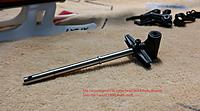 Views: 455
Views: 455
Figure 3: The FBL rotor head block bolts directly onto the Fusion 180's main shaft. -
 Views: 408
Views: 408
Figure 4: The Fusion 180's main shaft positions the rotor head block about 1.0 mm closer to the servos than does the main shaft of the 150S. -
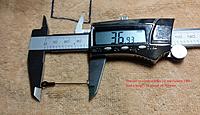 Views: 414
Views: 414
Figure 5: The servo control links on my Fusion 180 had a length of about 36.93 mm. -
 Views: 430
Views: 430
Figure 6: Brand new servo control links have a length of about 37.38 mm. -
 Views: 399
Views: 399
Figure 7: The new servo control links must be shortened to about 36.46 mm. -
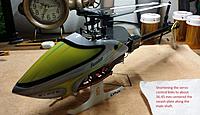 Views: 431
Views: 431
Figure 8: Shortening the servo control links to about 36.46 mm centered the swash plate along the main shaft.
-
 Views: 371
Views: 371
Figure 1: A battery cable adapter allows Trex 150X batteries to be used in the mCPX BL2. -
 Views: 387
Views: 387
Figure 2: This modification involves mounting a JST-XH 2.50 mm straight plug onto the battery tray of the mCPX BL2. -
 Views: 409
Views: 409
Figure 3: JST-XH 2.50 mm (1x3) straight plugs are available from Hansen Hobbies, Inc. -
 Views: 414
Views: 414
Figure 4: Heating the pins just a bit is enough to mark the pin locations on the battery tray. -
 Views: 388
Views: 388
Figure 5: Once heated enough, the pins easily push through the plastic battery tray. -
 Views: 406
Views: 406
Figure 6: Wires soldered onto the plug pins at an angle to prevent the pins from pulling loose from the battery tray. -
 Views: 409
Views: 409
Figure 6A: Discovered the receiver antenna hanging on by just a few strands! -
 Views: 388
Views: 388
Figure 6B: Re-flowing the solder seems to have fixed the antenna.
-
 Views: 569
Views: 569
Figure 1: My mCPX BL2 with a MicroHeli frame. -
 Views: 758
Views: 758
Figure 2: The MicroHeli frame includes carbon fiber frame sides that screw onto metal bearing blocks. -
 Views: 734
Views: 734
Figure 3: Receiver board and sticky cushion must be gently removed from the stock frame. -
 Views: 782
Views: 782
Figure 4: Using a MicroHeli swash leveler to level the swash plate. -
 Views: 747
Views: 747
Figure 5: The MicroHeli frame includes a metal boom mount that includes a screw to tighten onto the boom. -
 Views: 706
Views: 706
Figure 6: The MicroHeli frame supports attaching the antirotation bracket either in the stock side position or at the rear of the swash. -
 Views: 740
Views: 740
Figure 7: Time to let the thread-lock fully cure and then give this MicroHeli frame a maiden flight! -
 Views: 755
Views: 755
Figure 8: Boom mount rotates in MicroHeli frame during tail first crash.
-
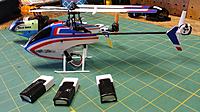 Views: 503
Views: 503
Figure 1: New mCPX BL2 is based on the mCPX BL but now includes Safe-Z mode and Safe mode. -
 Views: 592
Views: 592
Figure 2: My mCPX BL2 makes a great backup for my Trex 150X since they can use the same batteries. -
 Views: 582
Views: 582
Figure 3: Charging adapter BLH7713 plugs into battery plug of the mCPX BL2. -
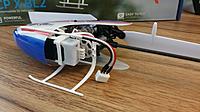 Views: 578
Views: 578
Figure 4: Charging adapter BLH7713 enables me to use Align 300 mAh packs in my mCPX BL2. -
 Views: 613
Views: 613
Figure 5: Small pieces of soft Velcro reduce vibes and hold the battery securely in the tray. -
 Views: 567
Views: 567
Figure 6: Microheli main frame should be stronger than the stock main frame.
-
 Views: 535
Views: 535
Figure 1: One of the downsides to owning a Blade Nano S2 is the canopy posts are prone to breaking in even minor crashes, allowing the receiver board to wiggle around inside the canopy. -
 Views: 703
Views: 703
Figure 2: An old gift card is cut to fit between the receiver board and the frame without touching the board. -
 Views: 692
Views: 692
Figure 3: A sticky foam pad fastens a lower portion of the receiver board to the gift card. -
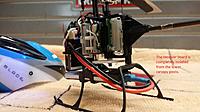 Views: 651
Views: 651
Figure 4: The receiver board is completely isolated from the lower canopy posts. -
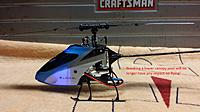 Views: 606
Views: 606
Figure 5: Breaking a lower canopy post won't have any impact on flying.
